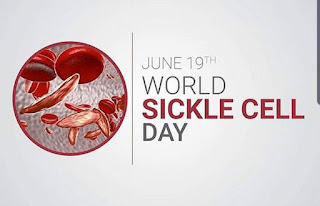JUNE 19th: WORLD SICKLE CELL AWARENESS DAY.
World Sickle Cell Day is a United Nation’s recognised day to raise awareness on sickle cell at a national and international level.
On December 22, 2008, the United Nations General Assembly adopted a resolution recognizing sickle cell disease as a public health problem and “one of the world’s foremost genetic diseases.” The resolution calls for members to raise awareness of sickle cell on the 19th of June each year. The international awareness day is observed annually with the goal to increase public knowledge and an understanding of sickle cell disease, and the challenges experienced by patients and their families and caregivers.
Sickle cell disease is an inherited blood disorder usually diagnosed at birth. Most people with the disease begin to show symptoms by 4 months of age or shortly thereafter. Genes come in pairs. One set is inherited from the mother and one set from the father.
To be born with sickle cell disease, a child has to inherit a copy of the sickle cell gene from both their parents. This usually happens when both parents are "carriers" of the sickle cell gene, also known as having the sickle cell trait. It can also happen when 1 parent has sickle cell disease and the other is a carrier of it.
Sickle cell carriers do not necessarily have sickle cell disease themselves, but there's a chance they could have a child with sickle cell disease if they are both carriers. If both parents are sickle cell carriers, there's a:
-1 in 4 chance each child they have will not inherit any sickle cell genes and will not have sickle cell disease or be able to pass it on.
-1 in 2 chance each child they have will just inherit a copy of the sickle cell gene from 1 parent and be a carrier.
-1 in 4 chance each child they have will inherit copies of the sickle cell gene from both parents and will be born with sickle cell disease.
Early diagnosis of sickle cell disease is essential in providing proper preventative treatment for some of the devastating potential complications.
Sickle cell disease can be identified by the following tests:
+Review of Newborn Screening Results
+Hemoglobin Electrophoresis
+Complete Family History
+Additional Blood Tests
+Genetic Testing.
+Newborn screening Certain newborn screening tests are supposed to be done within the first few days of life on every baby to detect serious, life-threatening diseases.
+Hemoglobin Electrophoresis It is a test that measures the different types of hemoglobin in the blood. It also looks for abnormal types of hemoglobin. Normal types of hemoglobin include: -Hemoglobin (Hgb) A, the most common type of hemoglobin in healthy adults. -Hemoglobin (Hgb) F, fetal hemoglobin.
+Complete Family History; A complete record includes information from three generations of relatives, including children, brothers and sisters, parents, aunts and uncles, nieces and nephews, grandparents, and cousins. Families have similar genetic backgrounds, and often similar environments and lifestyles. Together, these factors can give clues to conditions that may run in a family. By noticing patterns of disorders among relatives, healthcare professionals can determine whether an individual, family members, or future generations may be at an increased risk of developing a particular condition.A family history also can provide information about the risk of rarer conditions caused by variants (mutations) in a single gene, such as cystic fibrosis and sickle cell disease.
+Additional Blood Test; A typical routine blood test is the complete blood count, also called CBC, to count your red and white blood cells as well as measure your hemoglobin levels and other blood components. This test can uncover anemia, infection, and even cancer of the blood. A full understanding of your blood test results can help you make good decisions about your diet and lifestyle
+ Genetic Testing; Genetic testing is a type of medical test that identifies changes in chromosomes, genes, or proteins. The results of a genetic test can confirm or rule out a suspected genetic condition or help determine a person’s chance of developing or passing on a genetic disorder. In addition, using genetic testing, we are able to identify the specific type of sickle cell disease as well as your child’s unique genetic variations.
Health statistics in Cameroon indicates that close to 6000 people are living with the sickle cell disease. These persons are considered as Sickle cell disease warriors, for having fought the disease from birth. To help reduce this number, partners are encourage to know the stakes of each other before engaging as life partners.
By Arnaud Kouamo





Comments
Post a Comment